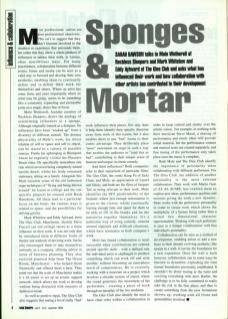Most professional artists are also professional observers. This isn't to suggest that they don't become involved in the situation or experience that surrounds them, but rather that they allow a whole plethora of influences to inform their work, in various often non-obvious ways. For many practitioners, collaboration between different artists, forms and media can be seen as a valid way to forward and develop their own aesthetic, enabling them to continually define and redefine their work for themselves and others. Where an artist has come from, and more importantly where an artist may be going, seems to be something like a constantly expanding and permeable point on a single, direct line of focus.
Mole Wetherell, founder member of Reckless Sleepers, draws the analogy of assimilating influences to a sponge. Although originally trained as a designer, his influences have been ‘soaked up’ from a diversity of different stimuli. The distinct physicality of Mole's work, his direct relation of self to space and self to object, can be traced to a variety of possible sources. Firstly his upbringing in Blackpool where he regularly visited the Pleasure Beach rides. He specifically remembers one ride which involved being completely turned upside down, whilst his body remained stationary, sitting on a bench. Alongside this Mole recounts some of the old fashioned stage techniques of ‘flying and being thrown around’ he learnt at college and the site-specific projects he created with Bush Hartshorn. All these lead to a particular focus on the body: the various ways it related to space, and the possibilities for defying gravity
Mark Whitelaw and Eddy Aylward, from The Glee Club, Manchester, identify Steve Purcell (an old college tutor) as a main influence on their work. It was not only that he introduced them to different forms of theatre and methods of devising work, but he also encouraged them to take themselves seriously as a company, offering advice in areas of business planning. They also received practical help from The Green Room, Manchester – who helped them financially and offered them a base. They point out that the scale of Manchester makes it a lot easier to set up an artistic support network, which allows the work to develop without being distracted with concerns of fashion or trend.
As well as positive input, The Glee Club also suggests that seeing a lot of really ‘bad’ work influences their pieces. Not only does it help them identify their specific direction away from work of this nature, but it also enables them to use ‘bad’ forms to their comic advantage. They deliberately place ‘poor’ movement on stage in such a way as to enable the audience to read this as ‘bad’, contributing to their unique sense of humour and tongue-in-cheek comedy.
And their influences? Both companies refer to their enjoyment of particular films: The Glee Club, the comic Kung Fu of Jackie Chan; and Mole, an appreciation of Laurel and Hardy. Both see the films of Jacques Tati as being relevant to their work. Mole identifies the 98% predictability of the humour, where just enough information is given to the viewer, whilst continually leaving enough time and space for them to be able to fill in the blanks and tie the narratives together themselves. It's a particular way of using comedy, centred around slapstick and difficult situations, which has resonance in both company's work.
Mole has found collaboration is most successful when contributions are centred around specific skills – with a defined role the individual artist is challenged to produce something which can work off and with another, without becoming an amorphous mesh of compromises. He is currently working with a musician on a project which involves a circular system of sound, where the sound generates the movement of the performers, creating a piece of work through an interplay of the two mediums.
The Glee Club also identify the need to have clear roles within a collaboration in order to keep control and clarity over the artistic vision. For example, in working with their musician Steve Mead, a sharing of performance and music ideas will provide initial material, but the performance content and musical score are created separately, and fine tuning of the performance only takes place once the music is complete.
Both Mole and The Glee Club identify the importance of personality when collaborating with different performers. For The Glee Club, the addition of another personality is the most relevant collaboration. Their work with Martin Gent of dA dA dUMB. has enabled them to explore new ideas, performance qualities and tensions, giving the work a new dynamic. Mole works with the performers' personality in order to create work which shows the multiplicity of a human being rather than a stilted two-dimensional character representation. Working with each performer is seen as a unique collaboration with that individual's personality.
Collaboration can be seen as a method of development, enabling artists to add a new layer to their already evolving aesthetic; like mortar in a wall, it can lay the foundation for a new expansion. Once the wall is built however, collaboration can in some ways be likened to dynamite: exploding the firm formal boundaries previously established. It shouldn't be about staring at the ruins and covering everything with dust. Rather, the challenge is to be fully committed to really take the risk in the first place, and then to create something from the new formations thrown up, working with all forms and personalities involved.

